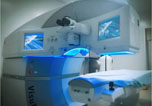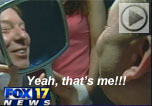- Over 55,000 LASIK and cataract procedures (including on over 4,000 doctors)
- The FIRST center in TN to offer Laser Cataract Surgery
- Introduced bladeless all-laser LASIK to the state
- Implanted the state's first FOREVER YOUNG™ Lens
- The first surgeons in the US to perform a new Intacs surgery to treat keratoconus
- Helped patients from 40 states and 55 countries
- International referral center for cataract surgery and LASIK complications
- Read Dr. Wang's book: LASIK Vision Correction
Why did you decide to have LASIK? Why did you choose Dr. Wang? How has your life changed since your LASIK procedure?
What is your advice for people considering LASIK?
Click to read more
Chapter TenRisks and ComplicationsIn order to make a decision as to whether LASIK vision correction surgery is a good alternative for you, it is important to understand the potential risks. If performed by an experienced surgeon, the risks are low--it is one of the safest surgeries performed today. In contrast to PRK, most risks in LASIK are related to the creation and re-adhesion of the corneal flap. The trade-off for these risks is fast visual recovery with less discomfort. And, in most cases, LASIK is the easiest procedure to fine tune. The following are several potential risks and side effects of LASIK: Unrealistic Expectations It is wise for those who undergo LASIK to be fully informed and carefully assess their expectations. As a patient, your job is to understand exactly what the procedure can and cannot do. This is where communication with your doctor is essential. Your surgeon should understand all of your expectations, and then explain what is realistic and what is not. Although this procedure is one of the most successful in all of medicine, even the most skilled and experienced surgeon cannot promise that you will have 20/20 vision without correction. A skilled LASIK surgeon can significantly reduce your dependence on glasses and contact lenses, but eventually most patients may need glasses for reading. Some may even need a thin pair of glasses for critical distance activities such as driving at night. It is best to think of this procedure as not eliminating but reducing your dependence upon glasses and contact lenses and improving your vision. Eyesight changes slightly over time, from one year to the next, even if you do not undergo surgery. Following LASIK, your eyes will still change slightly, not because the procedure was unstable, but rather because eyes simply change. For most people, their vision will not change enough to require the procedure to be performed again. Undercorrection For a given degree of nearsightedness or farsightedness, the amount of laser applied to a patient's cornea is based on a nomogram describing the average person's response to the laser. However, individuals are different and may not respond in an entirely average way to the laser. Usually, this difference in response is not visually significant, but sometimes an undercorrection or overcorrection will occur. Undercorrection is more common than overcorrection. A slight undercorrection will not seriously affect your vision and may be desirable following a nearsighted treatment in patients over forty to help with reading vision. More significant undercorrections may require an enhancement procedure (which is usually included in the original LASIK cost if performed within one or two years after the initial procedure). The incidence of undercorrection varies with prescription and is more common in patients with higher levels of nearsightedness, farsightedness, or astigmatism. For example, a patient with a prescription of less than 3.00 diopters of myopia has about a two percent chance of needing an enhancement procedure. On the other hand, a patient with more than 9.00 diopters of myopia has about a twelve to fifteen percent chance of requiring an enhancement procedure. Undercorrection is reduced by surgeons using consistent technique and constantly analyzing their outcomes. Your doctor should keep an up-to-date database of at least 1,000 procedures and be able to tell you what the likelihood is of needing retreatment, based on your preoperative refraction. The excimer laser comes from the factory with standard recommended settings. By fine tuning the factory treatment parameters, the surgeon minimizes the chance of significant undercorrection. Overcorrection An initial overcorrection may occur and usually corrects itself in the first month. Following a farsighted treatment, an overcorrection will make you temporarily nearsighted, making your distance vision somewhat blurry and your near vision rather good. Following a nearsighted treatment, an overcorrection will make your vision at close range more difficult. These temporary undercorrections and overcorrections can be managed with glasses until they resolve. The number of permanent overcorrections is fewer than that of undercorrections. As with undercorrection, a significant overcorrection may be treated with an enhancement procedure. This is usually performed three to six months following the initial treatment after your vision has stabilized. Induced Astigmatism In rare circumstances astigmatism can be induced following LASIK, resulting in blurred vision postoperatively. Astigmatism can be easily managed in combination with either an overcorrection or undercorrection retreatment (if necessary). If your vision does not meet your expectations after the primary treatment, there is a ninety-eight percent chance that it can be corrected with enhancement LASIK retreatments. Enhancement Procedures The addition of more laser to correct an over or under response to LASIK is generally performed two to three months after the original treatment at no additional cost to the patient. The original flap created during the LASIK procedure is undermined and lifted with a special spatula-like instrument. There is usually no need to cut a new flap; thus, the risks associated with creating the flap originally are not a factor in retreatment. There are times when a new flap formation may be necessary, but the risk of epithelial ingrowth is increased compared to the initial procedure. The postoperative course is the same as with the original procedure. "Enhancement" is a funny word to use for additional surgery. It implies that the surgeon is going to make your vision better. It does not say, "The surgeon is going to try to make it better but may make it worse." Neither does it say, "An enhancement carries many of the same risks of the initial surgery, and in some cases more." Discuss enhancement procedures carefully with your surgeon and do not undergo unnecessary or unwarranted procedures. Dry Eye It is not uncommon for patients to experience a "grittiness" in the eye following LASIK. This condition usually tends to resolve itself over the first one to three months. In the meantime, adequate application of the lubricating eye drops recommended by your surgeon will often alleviate the symptoms. It is important that your doctor evaluate you for dry eye prior to the LASIK procedure. Tell your doctor if you experience dry eye symptoms with contact lenses or glasses. If dryness exists prior to surgery, or if dry eye symptoms persist after surgery despite the frequent use of artificial tears, your doctor may recommend blocking your tear drainage canals with punctum plugs. This brief, painless procedure prevents your natural tears from draining away so quickly and results in improved lubrication of the surface of the eye. Haze Haze is the term used for a cellular reaction that occasionally develops in the corneal stroma following surface laser refractive procedures (PRK). It is the result of material being secreted from the surface cells and deposited in the anterior corneal stroma. Serious haze occurs extremely rarely with LASIK and in less than one percent of patients who have undergone PRK. Even a moderate amount of haze will not affect your vision. Following PRK, haze may be aggravated by ultraviolet light (sunlight), so it is important to wear good ultraviolet protection when in bright sunlight. Ultraviolet light does not cause haze following a LASIK operation. Increasing the frequency of steroid drops or irrigating underneath the LASIK flap will usually enable the haze to resolve without affecting your vision. Rarely, however, haze can cause a reduction in the crispness and clarity of vision, and possibly a reduction in best corrected vision. This is a more serious condition. Fortunately, haze can be removed permanently with mechanical debridement combined with the application of a drug called Mitomycin C. This may restore the vision back to normal. Corneal Abrasion It is possible to develop a small corneal abrasion during LASIK. Despite excellent surgical technique and an adequately moistened eye, a small breakdown in the epithelial surface may develop as the flap is made. This occurs in approximately five percent of LASIK procedures because the surface cells do not adhere well. The medical term for this is epithelial basement membrane disorder. Unfortunately, surgeons cannot always detect this preoperatively. A very thin bandage contact lens may be placed on the eye by the surgeon if this occurs. It improves comfort and promotes healing. The bandage contact lens is removed the next day. Fortunately, the epithelium grows back so fast that eyes with an epithelial defect usually heal within one to three days, even without a contact lens. Long-term effects are rare. Your vision will be blurred during the time that the abrasion is healing. If a central defect occurs during your procedure, the surgeon should wait to do the other eye until the first eye heals and has clear vision, usually one to two weeks. It is likely that your other eye will have a corneal abrasion as well when it undergoes LASIK, although lubricating drops used at the time of surgery may help to prevent it. In some cases recurrent erosions of the abrasion may occur and require further medical treatment and possible laser surgery. But, again, long-term effects are rare. Night Glare and Halos Many nearsighted patients who wear glasses or contacts have symptoms of glare or see halos or starbursts at night. This is due to having longer eyes than normal sighted patients. Thus, at night in a nearsighted patient when the pupil dilates, peripheral light rays are scattered more before they reach the retina. It is this scattering that results in glare and halos. These symptoms are sometimes more bothersome after laser surgery, especially if the pupil dilates beyond the size of the treatment zone. While many patients may see halos or a ghosting of images at night during the first month following treatment, it is quite uncommon for these side effects to interfere with their activities. The effects usually improve in the first three months, and the overwhelming majority of significant glare problems resolve on their own by six months. If problems with glare do persist, patients tend to benefit from weak prescription night glasses or from the use of eye drops at dusk that reduce the size of their pupils. The side effect of glare and halos is difficult to predict. Some patients with very widely dilating pupils, large corrections, and astigmatism may be somewhat more prone to glare and halo effects. Special laser programs that allow larger treatment zones can help reduce the chance of these problems. Certain microkeratomes also allow for larger flap sizes that may help to eliminate an important type of disabling glare. It is important for your surgeon to know if you have problems with glare prior to your surgery. Loss of Best Corrected Vision A small number of patients may experience a slight loss of visual sharpness following LASIK vision correction. This means that even with your best correction, you may lose the ability to read the bottom one to three lines of the eye chart. This can be due to irregular healing or an irregular flap and may improve over the first year. Careful surgical technique and good follow-up care help minimize the incidence of this problem. On very rare occasions, one of the above-mentioned complications may lead to a reduction in your best corrected visual acuity. This means that even with glasses, you may lose some of the crispness and clarity to your vision and no longer be able to read the 20/20 line on the eye chart. Usually, however, the reduction in vision is modest, and you can still read the 20/30 or 20/40 line on the eye chart. A reduction in best corrected vision occurs when patients develop significant haze, diffuse lamellar keratitis, or persistent striae (wrinkles or folds in the cap). All of these complications are extremely rare. A reduction of two or more lines of vision can occur in less than one percent of patients as a result. Most of the time these conditions can be reversed. Central Islands Another source of reduction of vision--ghost images or other visual disturbances after LASIK--is a central island. This is the result of a small raised area in the treatment zone that receives less laser energy and does not obtain full ablation compared to the surrounding tissue. Occasionally, a central island spontaneously disappears after several months, but many require an enhancement procedure where the cap is lifted and a small amount of excimer laser energy is delivered to treat the raised area. The diagnosis of a central island is made with the corneal topographer, which produces a digitized contour map of the corneal surface. The raised central island can easily be identified by a color-coded topographical map. When the central island is removed by additional laser treatment, crisp, sharp vision generally returns. Corneal Flap Risks For experienced surgeons, corneal flap risks are rare. If they occur, they tend to occur at the time of surgery. Typically, the flap may be too small, too short, or irregular. There is also a possibility that the flap may be created without a hinge (very rare with today's newer microkeratomes). Sometimes postoperatively the corneal flap may shift slightly. Hence, it is important--especially during the first few hours--not to rub the eye or squeeze the eyelids excessively and to keep the eyes well lubricated. If the flap shifts slightly, wrinkles (striae) may result. If these striae are present in the center of the cornea, they may distort vision and require smoothing out. This is done by lifting the original flap and ironing them out with a special instrument. When treated early, striae can usually be completely removed. Occasionally, however, they can be difficult to treat, and rarely they can lead to a reduction in best corrected vision. While any problem with the corneal flap can result in the loss of best corrected vision, the good news is that the overwhelming majority of flap-related complications are easily managed and rarely have serious consequences in the long run. If a flap complication occurs, this is the time when you hope you have a truly experienced surgeon to manage it appropriately. If there are problems with a flap, your surgeon may elect not to go ahead with the procedure but perform it at a later date after the eye heals. Allowing the cornea to heal for two to four months is usually adequate. The incidence of visually significant, flap-related complications among experienced LASIK surgeons is less than one percent. It is important to understand that even if these complications occur, it may take several months to get a complete return of vision following correction of the problem. Epithelial Ingrowth Rarely, some of the corneal surface cells (epithelium) may get trapped beneath the flap created during the LASIK procedure. These cells typically do not create any problem, but occasionally they can cause postoperative blurred vision or irritation. This problem can be easily identified and treated by gently lifting the flap and removing the trapped epithelial cells. Regression Regression refers to the tendency of the eye to drift back slightly toward its original prescription. This occurs more commonly in patients who have had PRK but occasionally occurs in patients with higher amounts of myopia, hyperopia, or astigmatism who have undergone LASIK. If a significant regression does occur, enhancement procedures may be performed to "tune up" the original treatment, provided your cornea is thick enough to allow retreatment. Enhancements for regression are usually performed three to six months following the original procedure to allow time for the patient's new refraction to stabilize. In some cases, glasses for night driving may be all that is needed. Diffuse Lamellar Keratitis (DLK) Diffuse lamellar keratitis--also known as the "sands of the Sahara" syndrome--is a general inflammation that sometimes arises between the corneal flap and the underlying corneal stroma. Diffuse lamellar keratitis (DLK) is an extremely rare inflammatory reaction that leaves small white deposits underneath the corneal flap after LASIK. The cause of this reaction is unknown. Depending on the amount of inflammation, you may have no symptoms or you may note some haziness in your vision. Prevention requires maintaining a clean interface between these two areas. This is aided by meticulously draping the eyelids with sterile tape to keep the eyelashes out of the surgical field and by irrigating (rinsing) the cornea to remove any debris that may be in the tear film before making the microkeratome cut. When folding back the flap, it is important to try to prevent any unwanted debris from accumulating on the interface surface. Irrigating under the flap following the application of the laser may also help to assure a clean interface. Despite meticulous surgical technique, at times sebaceous secretions from the patient's own eyelid border may appear beneath the flap. This is usually of no consequence. Occasionally, microfibers from the sterile drapes or swabs may appear. Airborne particulate fibers are also occasionally seen as well as an occasional metallic fragment from the high speed keratome blade. Fortunately, most particulate matter does not cause problems unless it is in the visual axis. By drying around the edges of the eye, the surgeon insures that when the corneal flap is folded back, it will not be sitting in a pool of dirty fluid. Postoperatively, a topical corticosteroid (medicated drop applied to the surface of the eye) is used to suppress inflammation. The steroid is applied for one week because diffuse lamellar keratitis peaks two to five days after surgery. Likewise, a single drop of a nonsteroidal, anti-inflammatory eye drop at the conclusion of surgery is essential. It serves to dramatically reduce pain during the first six hours after surgery. When present, most cases of diffuse lamellar keratitis respond to treatment by corticosteroid drops. More severe cases may require that the surgeon lift the corneal flap and irrigate beneath it to remove the inflammatory cells. When recognized and treated properly, DLK rarely affects the ultimate visual outcome; in rare cases, DLK will cause a loss of best corrected vision. A different form of lamellar keratitis has recently been reported, central lamellar keratitis or CLK. CLK appears within the first twenty-four to forty-eight hours and results in a severe central collection of inflammatory debris. At times the underlying stroma is also involved. Treatment is similar to DLK. However, vision may be more often affected, resulting in the need for additional enhancements after recovery. At the time of this writing, the exact causes of DLK and CLK are unknown. Speculation of causative factors include everything from an inflammatory reaction related to the patient's own sebaceous secretions, to reactions to methlycellulose drops, antigens from bacteria, and even immune reactions to byproducts of the laser treated cornea. Infection or Severe Inflammation Although infection is the most feared complication, it is extremely rare. As with any surgery, it is avoided through sterile surgical technique. If it does occur, it manifests itself in the first forty-eight to seventy-two hours after treatment. That is why it is important to avoid any contact with substances that may cause infection, such as eye makeup, hot tubs, and swimming pool water, for the first week. It is additionally imperative for you to go to all of your follow-up visits, even if everything seems to be fine. You will receive antibiotic drops postoperatively to help prevent infection. Summary LASIK is the procedure of choice for virtually all but the most extreme myopes and hyperopes. In addition, most degrees of astigmatism can be treated. It is also a very precise procedure and allows for accurate enhancements when needed. |
If you're interested in bladelessLASIK, choose experience and technology. Choose Wang Vision 3D Cataract and LASIK Center of Nashville, Tennessee. Call (615)321-8881 or email us today.
Our new texbooks
A 501c(3) charity that has helped patients from over 40 states in the US and 55 countries, with all sight restoration surgeries performed free-of-charge.




















